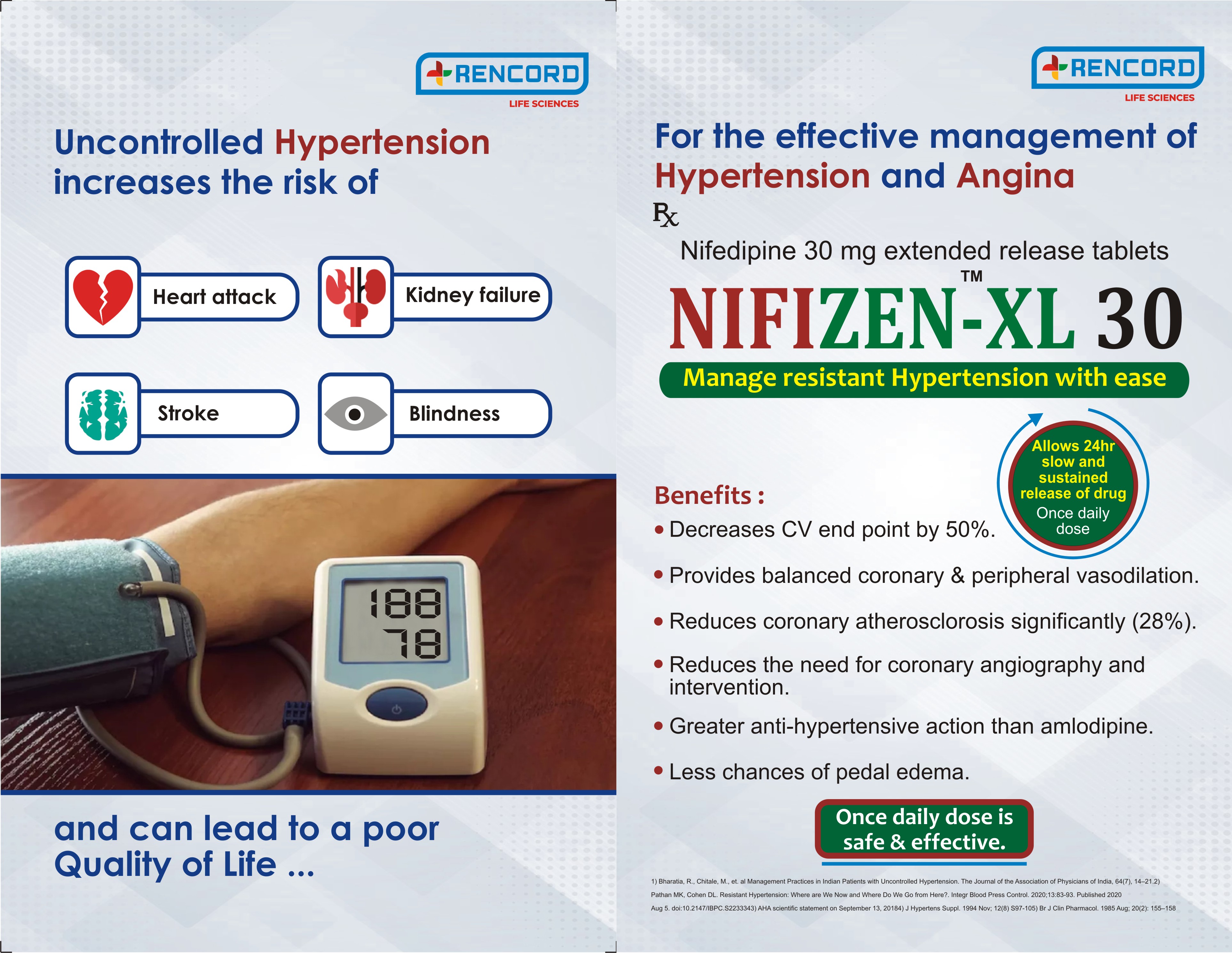Nifizen

Nifizen
Nifedipine is a calcium channel blocker used primarily for the treatment of hypertension (high blood pressure) and angina (chest pain). It works by relaxing blood vessels so blood can flow more easily, and by reducing the workload on the heart. Nifedipine comes in various formulations, including extended release (ER) and sustained release (SR).
Formulation: Extended Release
Dosage: 30 mg
Mechanism of Action: Provides a controlled release of nifedipine over 24 hours, allowing for once-daily dosing.
Indications: Primarily indicated for the management of chronic stable angina and hypertension.
Dosage and Administration: Typically taken once daily, with or without food. The tablet should not be crushed or chewed, as this can release the drug too quickly and increase the risk of side effects.
Common Side Effects: Dizziness, flushing, headache, weakness, swelling of ankles/feet (edema), and constipation.
Serious Side Effects: Hypotension (low blood pressure), heart failure, and significant allergic reactions (rare).
Nifizen Retard 20 -Nifedipine 20 mg Sustained Release (SR)
Formulation: Sustained Release
Dosage: 20 mg
Mechanism of Action: Provides a gradual release of nifedipine over 12 to 24 hours, depending on the specific product formulation.
Indications: Used for the treatment of chronic stable angina and hypertension.
Dosage and Administration: Typically taken once or twice daily, depending on the specific product and patient needs. Should be taken with food to enhance absorption. The tablet should not be crushed or chewed.
Common Side Effects: Similar to ER formulation, including dizziness, flushing, headache, weakness, edema, and constipation.
Serious Side Effects: Same as ER formulation, with potential for hypotension, heart failure, and significant allergic reactions.
Nifizen XL 60-Nifedipine 60 mg Extended Release (ER)
Formulation: Extended Release
Dosage: 60 mg
Mechanism of Action: Provides a controlled release of nifedipine over 24 hours, allowing for once-daily dosing.
Indications: Used for the management of chronic stable angina and hypertension. Higher dose formulations are typically reserved for patients who need more aggressive blood pressure control or have more severe symptoms.
Dosage and Administration: Taken once daily, with or without food. The tablet should not be crushed or chewed.
Common Side Effects: Dizziness, flushing, headache, weakness, edema, and constipation.
Serious Side Effects: Hypotension, heart failure, and significant allergic reactions.
General Precautions and Contraindications:
Precautions:
o Monitor Blood Pressure: Regular monitoring of blood pressure is necessary to ensure effectiveness and adjust dosages as needed.
o Avoid Grapefruit Juice: Grapefruit juice can increase the levels of nifedipine in the blood, leading to increased side effects.
o Heart Conditions: Use with caution in patients with heart failure or severe aortic stenosis.
o Liver Function: Patients with impaired liver function should use nifedipine cautiously and may require dose adjustments.
Contraindications:
o Known Allergy: Hypersensitivity to nifedipine or any component of the formulation.
o Cardiogenic Shock: Should not be used in patients with cardiogenic shock.
o Severe Aortic Stenosis: Due to the risk of exacerbating this condition.
Drug Interactions:
Beta-blockers: Concurrent use may increase the risk of hypotension and heart failure.
CYP3A4 Inhibitors: Drugs like ketoconazole, itraconazole, and erythromycin can increase nifedipine levels.
CYP3A4 Inducers: Drugs like rifampin and phenytoin can decrease nifedipine levels, reducing its effectiveness.
Digoxin: Nifedipine can affect the levels of digoxin in the blood.
